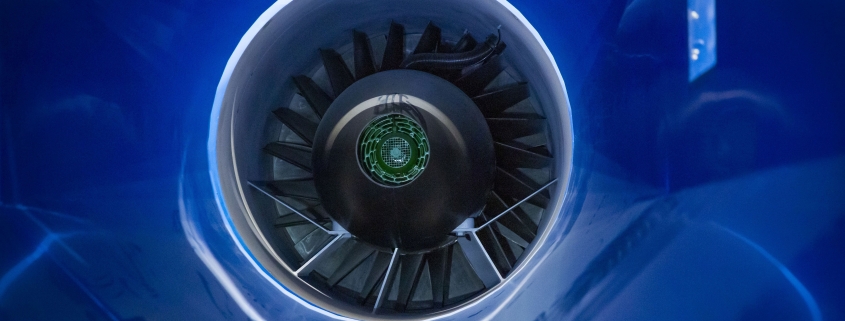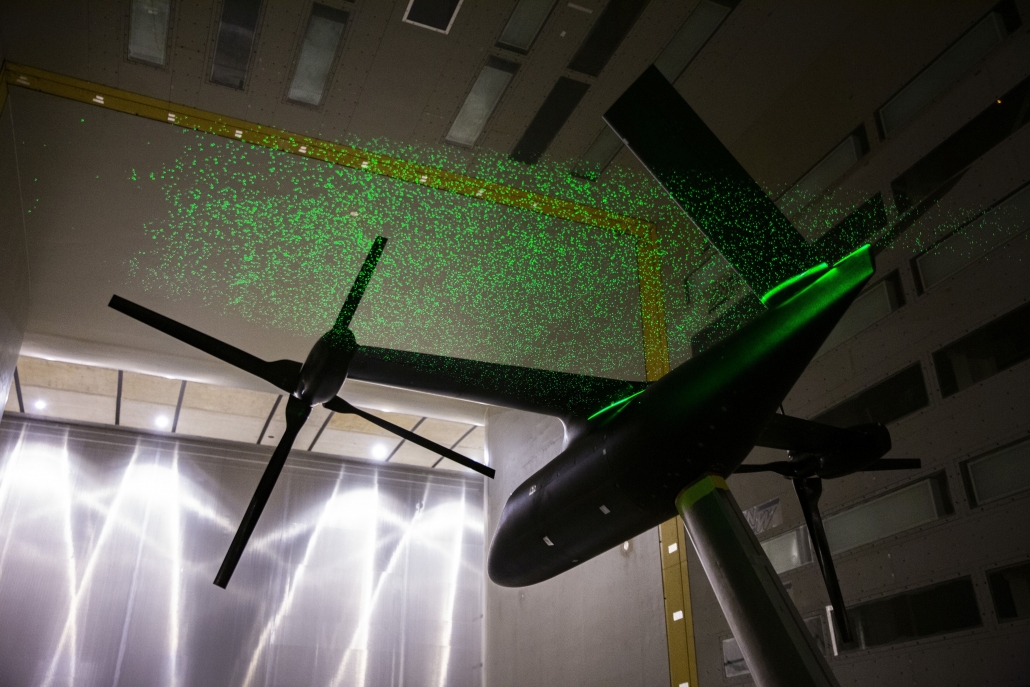Airports already face a challenge but in case the number of aircraft continues to increase, noise is becoming more a headache. As part of a public-private collaboration known as the Taste project, aviation propeller manufacturer Dowty is turning to NLR and its in-house developed technologies to precisely measure, and ultimately mitigate the noise at the source.
By Collin Arocho, Bits&Chips
With drones of all sizes, personal air transport and smaller planes increasingly filling the sky, propellers will be a mainstay of sky-bound transportation. This comes with its own set of challenges – specifically in the aviation industry. One challenge coming to light is the noise generated by the open blades of these aircraft flying at lower altitudes.
As a propeller rotates, it creates thrust due to the forces on its blades. This rotation also results in an acoustic field that’s perceived, particularly in the far field (at a distance from the source), as noise. The level of the disturbance directly correlates with the amount of force on, and the subsequent speed of, the turning blade and is seen as a growing nuisance, for both people on the ground, as well as those in the sky. Enter the British engineering company Dowty Propellers.
Taste
The UK-based aerospace experts, which specializes in the design and manufacturing of integrated propeller systems, wanted to investigate if these sound issues could be mitigated by identifying the sources. But before Dowty could set a hard goal of reducing noise, they first needed to determine if it was possible to get more accurate acoustic measurements. To do this, the British engineering company initiated a study, called Techniques for Acoustic Measurements in High-Speed Test Environments (Taste), and reached across the North Sea to the Royal Netherlands Aerospace Centre (NLR) for assistance in the project. In this collaboration, Dowty would provide its knowledge and expertise on propellers and rely on NLR’s experience in algorithm development and industrial testing, before finally turning to the low-speed wind tunnel facilities of NLR’s sister institute German-Dutch Wind Tunnels (DNW), the third arm of this public-private alliance.
“Essentially, Dowty turned to us to see if we could get more accurate acoustic measurements from the propellers in a high-speed environment, which is certainly not a trivial task,” describes Marthijn Tuinstra, a principal scientist at NLR. “To achieve this, though, we’ll need to advance the state-of-the-art in measuring techniques.”
Acoustic array
One main issue with measuring in a high-speed environment is that these tests use scale models and take place in wind tunnels, which are in no way constructed to provide interference-free sound testing. “Ideally, you’d need a large-scale tunnel that’s completely covered with acoustic materials to block reflective sounds and ensure you’re measuring the desired sound source – a model propeller in this case. The problem is, for high-speed measurements, these facilities don’t really exist,” poses Tuinstra. Therefore, NLR is developing algorithms and measurement techniques to be able to deal with the challenges coming with such a nonideal test environment. One of these acoustic measurement techniques to be employed is the acoustic array.
“Think of the array as a camera, but the lens is replaced with an array of microphones. Employing digital processing techniques, all the microphones are focused on a fixed point in space and used to measure the sound,” illustrates Tuinstra. “The easiest way to explain it is, if you were to point two microphones in space to record a sound. The sound first will be picked up on one microphone, and at a different time on the second microphone, due to the location and trajectory of the sound waves. This is what we call a phase delay. With this phase delay, we can determine from where that sound is emanating. By using more microphones, we’re able to record much more accurate measurements.”
Soap bubbles
To avoid reflections contaminating acoustic measurements in a closed wind tunnel, NLR has another trick up its sleeve. Instead of measuring sound directly, researchers will look to measure the velocity field in the wake of the propeller blades. From this velocity field, blade loading – the amount of thrust on the propeller blades as they rotate – can be determined. By employing this method, investigators can measure the acoustic pressure fluctuations generated by the propellers.
“To measure the velocity field, we make use of particle image velocimetry – the measurement of velocity in fluids – which uses particle tracers consisting of helium-filled soap bubbles,” tells Evelien van Bokhorst, the project leader of the Taste project and an R&D engineer at NLR. “With these particle tracers, we’re able to capture a large field of view, which is necessary as each model propeller blade measures 30 cm long. Recently, we developed a system at NLR exactly for this purpose.”
Acoustic processing
Acoustic array and particle tracing, however, are only two of the innovative methods in the Taste project’s three-pronged approach. A third technique that collaborators are looking to utilize is another NLR innovation: in-house developed software systems and enhanced algorithms. “This is the really innovative part of the project. We’re designing tailor-made acoustic processing algorithms to measure propeller noise. These algorithms can then be modified to fit with a specific facility, allowing us to get more information out of the measurements,” highlights Tuinstra.
Even with these advances in innovation, the Taste project is still in the early stages – the preparation stage. While wind tunnel testing is slated to commence in the summer of 2020, the team is still working on modeling and simulation aspects of the project – meaning there’s still quite some ground to cover. “Currently, our focus is really on data post-processing techniques and adjusting our algorithms. This will allow us to enhance our existing beamforming techniques and get a more accurate picture of the sound field,” expresses Van Bokhorst. “The next step is to move into testing at small scale in NLR’s research wind tunnel, NLR-AWT. After that, we’ll move to an industrial-scale test, but still at low speeds. For this, tests will be carried out at the low-speed tunnels of DNW. With these wind tunnel tests, we’ll apply and combine our traditional and novel methods to be able to measure and describe the sound field generated by propellers in the best way possible,” concludes Van Bokhorst.
Within the Techniques for Acoustic Measurements in High-Speed Test Environments (Taste) project, NLR – Royal Netherlands Aerospace Centre is looking into possible methods to accurately measure and mitigate the noise produced by propeller-driven aircraft. Partners include UK-based Dowty Propellers and NLR’s sister organisation German-Dutch Wind Tunnels (DNW). NLR participation is co-funded by Holland High Tech, Top Sector HTSM, with a public-private partnership grant for research and innovation.



 NanoAvionics
NanoAvionics